COVID-19 Winter Plan - summary
Updated 2 December 2020
This is a summary of the government’s COVID-19 Winter Plan.
The full version sets out our programme for suppressing the virus, protecting the NHS and the vulnerable, keeping education and the economy going and providing a route back to normality.
1. The government’s objectives
The government’s strategy will be guided by three objectives:
- suppressing the spread of infection
- finding new and more effective ways of managing the virus and enabling life to return closer to normal
- minimising damage to the economy and society, jobs and livelihoods. And ensuring education is safeguarded in nurseries, schools, colleges and universities
2. Route back to normality
Over the coming months, the government will be able to rely less on economic and social restrictions and more on solutions provided by scientific progress.
Vaccines are at the centre of the government’s plan to ensure life can return to as normal as possible. The government has announced agreements with seven different vaccine developers, securing access to more than 350 million doses to be made available across the UK. Next month, the government will be ready for a UK-wide vaccination programme to begin, provided regulators approve the vaccines.
The safety of the public will always come first. A COVID-19 vaccine will only be approved for use if it has met robust standards on safety, effectiveness and quality through clinical trials.
Effective treatments for COVID-19 will continue to be vital to manage the virus even as vaccines are rolled out in the UK and globally, including for those who cannot be vaccinated, for example because they are immunocompromised. Finding effective treatments will reduce risk to lives and serious illness for people who do contract the virus and support the return to normal life.
A strengthened programme of community testing will allow us to identify and isolate people who do not have symptoms but are unintentionally spreading the virus. In addition, the government will also roll out rapid, regular testing nationally to NHS front-line staff, social care and other high-risk or critical settings.
Testing capacity for those with COVID-19 symptoms has increased almost five-fold in six months, from 100,000 a day at the end of April to 500,000 a day by the end of October, with plans to go even further by the end of the year. This is available to citizens in every part of the UK. The government is working to improve turnaround times for these tests despite the increase in scale and logistical complexity in the expanded network.
3. Controlling the virus
The scientific advances described above provide the route back to normality and should reduce the need for economic and social restrictions in the spring. But until these have been deployed, the government must continue to use other tools to suppress the virus.
4. A targeted approach in England
The COVID-19 Winter Plan also sets out how we will lift national restrictions in England on 2 December. This is only possible because everyone’s efforts during the current restrictions in England have slowed the spread of the virus and eased the pressure on the NHS.
On 2 December, across all of England, regardless of tier:
- the stay at home requirement will end, with travel being permitted again subject to guidance in each tier
- shops, personal care, gyms and the wider leisure sector will reopen
- collective worship, weddings and outdoor sports can resume
- people will no longer be limited to seeing only one other person in outdoor public spaces - the rule of 6 will now apply outdoors as it did in the previous set of tiers
However, the virus is still present and if we aren’t careful it could quickly get out of control again before vaccines and community testing can have an effect. That would put in jeopardy the progress the country has made and once again risk intolerable pressure on the NHS and squeezing out non-Covid patients from vital operations.
This is why, on 2 December, England will move back into a regional, tiered approach – because it is right to target the toughest measures in the areas where we are seeing higher rates of infection.
A summary of each of the tiers is below:
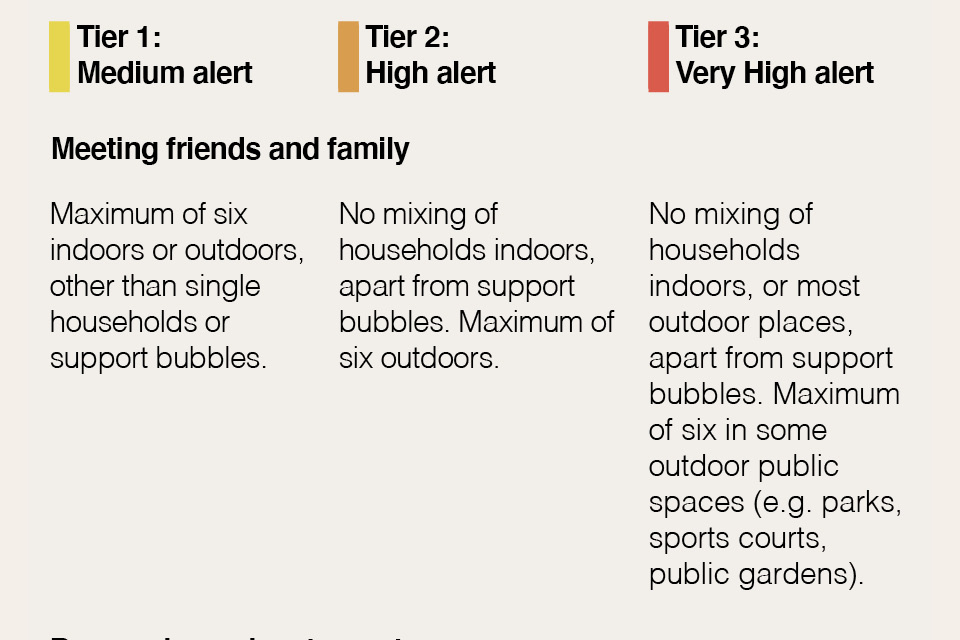
A table showing the different restrictions across the regional 3-tier system in England. This shows the rules for meeting friends and family.
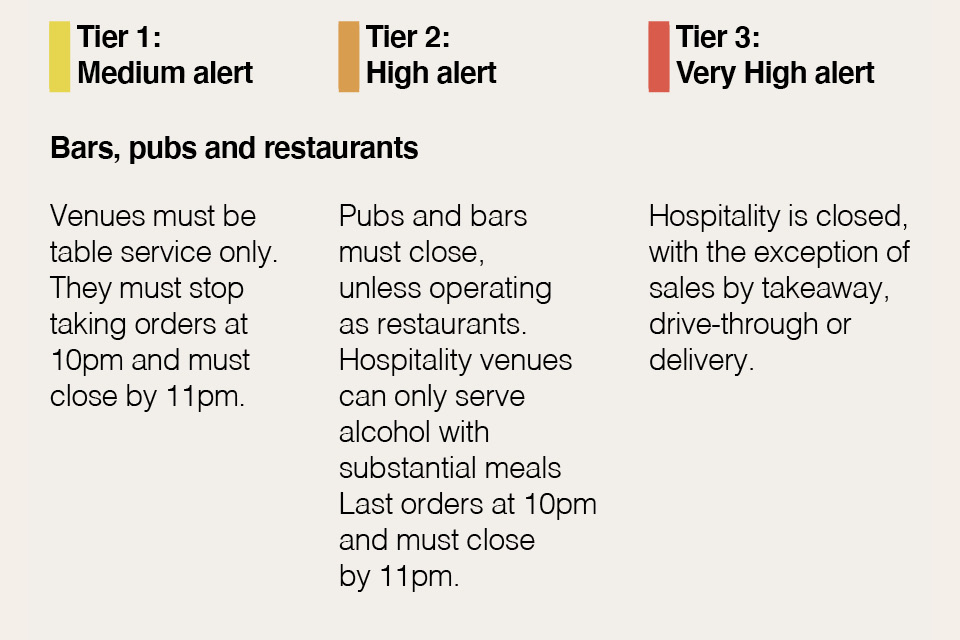
A table showing the different restrictions across the regional 3-tier system in England. This shows the rules for bars, pubs and restaurants.
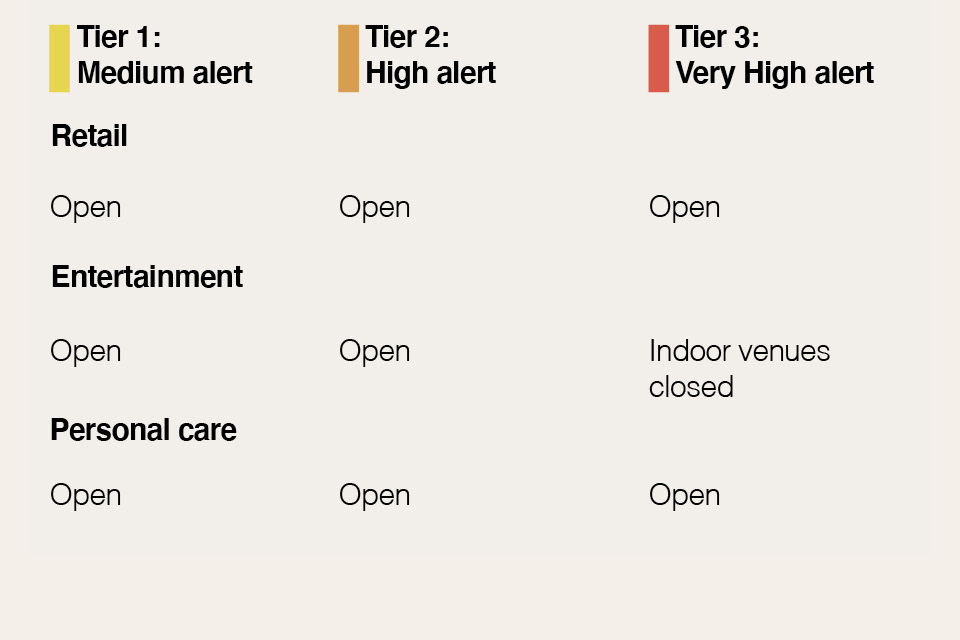
A table showing the different restrictions across the regional 3-tier system in England. This shows the rules for retail and personal care (open across all tiers) and entertainment (indoor venues closed in tier 3).

A table showing the different restrictions across the regional 3-tier system in England. This shows the rules for travel, where a different set of rules and guidance apply in each tier.
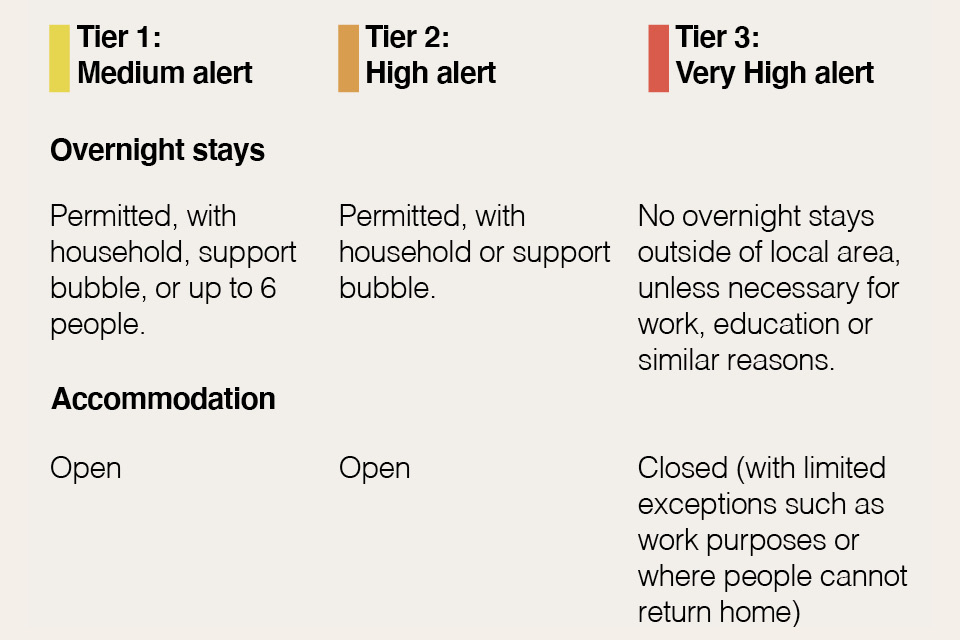
A table showing the different restrictions across the regional 3-tier system in England. This shows the rules for overnight stays and accommodation.
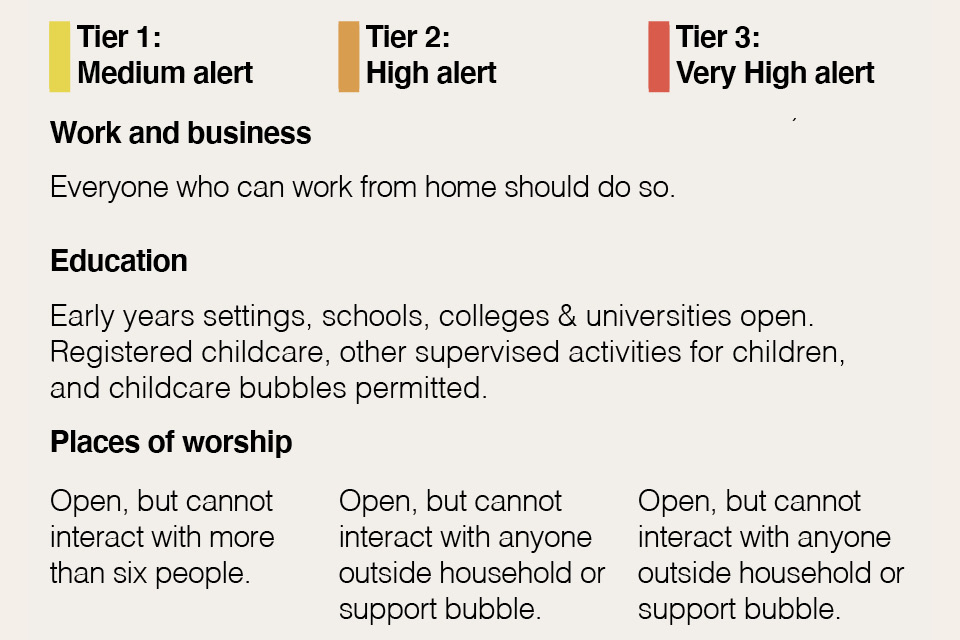
A table showing the different restrictions across the regional 3-tier system in England. This shows the rules for work and business, education and places of worship.

A table showing the different restrictions across the regional 3-tier system in England. This shows the rules for weddings and funerals.
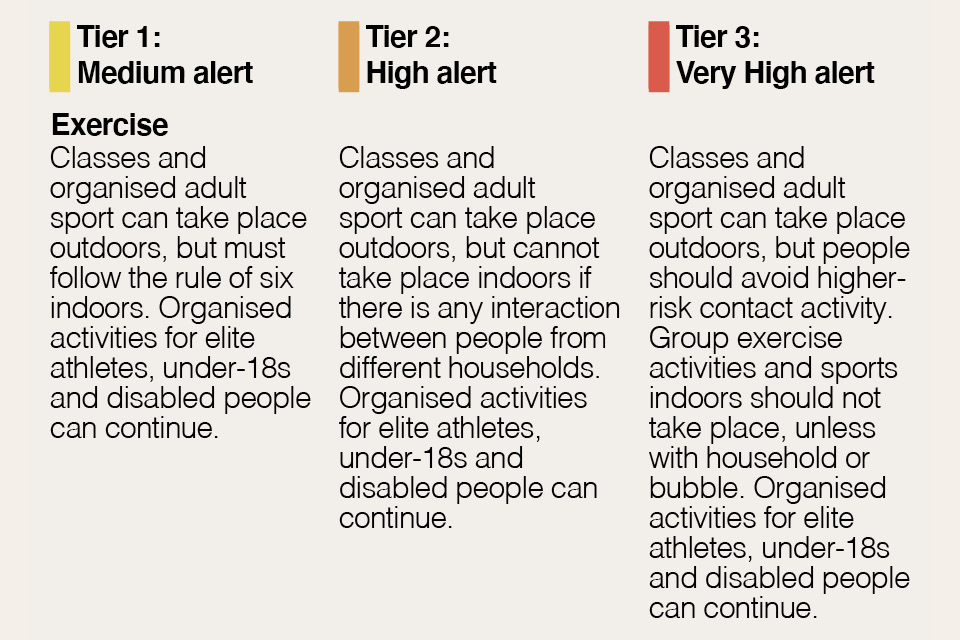
A table showing the different restrictions across the regional 3-tier system in England. This shows the rules for exercise.
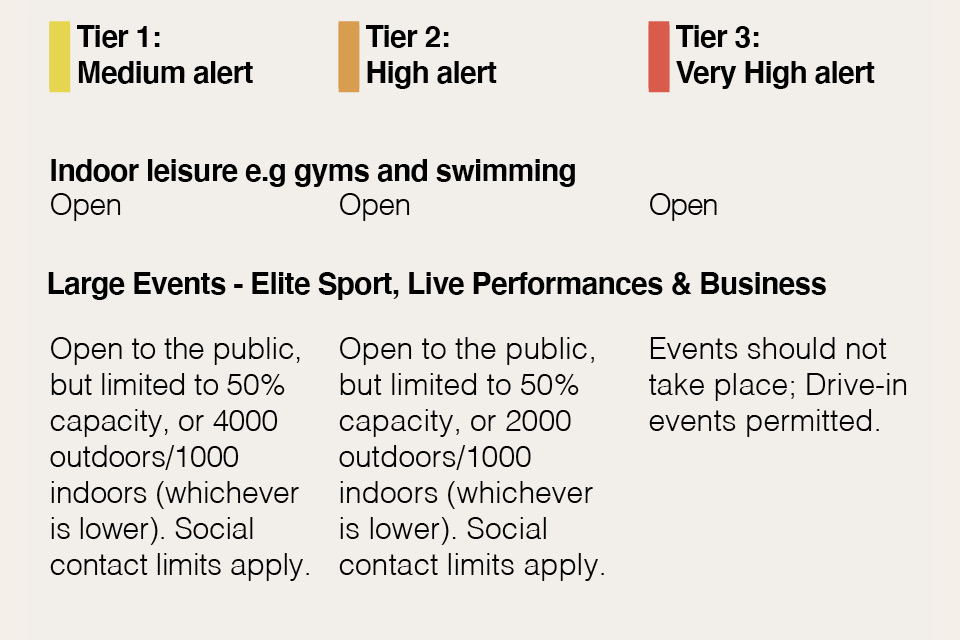
A table showing the different restrictions across the regional 3-tier system in England. This shows the rules for indoor leisure e.g. gyms and swimming, and large events - elite sport, live performances and business.
Stronger measures will be introduced in each tier to keep the virus under control:
- in tier 1, the government will reinforce the importance of working from home wherever possible
- in tier 2, pubs and bars must close, unless operating as restaurants, and hospitality venues can only serve alcohol with substantial meals
- in tier 3, all hospitality will close except for delivery, takeaway and drive-through; hotels and other accommodation providers must close (except for specific exemptions, including people staying for work purposes or where they cannot return home); and indoor entertainment and tourist venues must also close
The government will also refine the previous tiers:
- the 10pm closing time for hospitality has been modified to last orders at 10pm and closing time at 11pm. This allows customers to depart gradually and provides greater flexibility
- in tiers 1 or 2, spectator sport and business events can now resume inside and outside with capacity limits and social distancing, providing more consistency with indoor performances in theatres and concert halls
- the government is expanding eligibility of ‘support bubbles’ - this will help mitigate the impacts of the restrictions on parents of children aged under 1 (or under 5 and with a disability that necessitates continuous care) and for those households where a single adult cares for someone with a serious disability
These tiers are designed to suppress the spread of infection and therefore support areas to move down the tiers. The government will determine the tier each area will go into on 2 December and how areas move between tiers thereafter. This will be based on clear indicators of the level of the virus, the rate of increase and capacity in the NHS.
While less restrictive than the current national measures, the government recognises how tough these measures are for people and businesses that will be in tier 3, especially those parts of the country which have been under some form of restriction since the summer. This is why the government will offer Local Authorities the opportunity to work together on whole community testing and more targeted testing to high risk settings, in addition to scaling up the core testing regime. When accompanied by self-isolation of those testing positive, this substantial expansion of testing is a vital new tool to help areas get out of the toughest measures.
The impact on the economy and individuals’ livelihoods has been severe, despite the government’s actions. This is why the government has moved swiftly to support the economy and protect jobs across the four nations of the UK with the Coronavirus Job Retention Scheme, Self-Employment Income Support Scheme as well as a number of support schemes for businesses.
5. Christmas and beyond
The government recognises that Christmas is an important time of year for many people, all across the UK. Regardless of faith, the Christmas period is a time often spent with family and friends, with schools and offices closing and people travelling over the bank holidays.
Christmas will be different this year, but we will make sure people can see their loved ones. We are agreeing a common approach with the Devolved Administrations of Scotland, Northern Ireland and Wales for a time-limited change to social restrictions over the Christmas period so that families can be reunited across the UK.
The fact that this has been a difficult year for everyone means that time with loved ones will be even more important. For this reason the government will allow some increased social contact for everyone (supported by guidance on how to celebrate safely) over the Christmas period. Everybody should make sure they follow guidance to minimise risk to protect their loved ones particularly the most vulnerable.
The government also recognises the significant sacrifices that people of all faiths have made this year; restrictions have been in place over a number of religious celebrations and observances, and it is thanks to these sacrifices that it has been possible to control the virus. Communal worship will now be possible for all faiths in all three tiers and faith leaders will continue to play a key role, consulting on how to make religious practice as safe as possible.
This will not be risk-free: COVID-19 continues to pose a very real threat to the UK population throughout the end of the year and into 2021. This means that it will not be possible to celebrate Christmas in the “normal way.” Meeting up with other households will increase the risk of catching COVID-19 and passing it on to others. Each of us needs to take personal responsibility during the Christmas period to limit the spread of the virus, protect our loved ones and exercise particular caution with those who are vulnerable. It is critical that we all get tested when appropriate, self-isolate to protect others, remember the value of fresh air, and keep on protecting each other with Hands, Face, Space.
6. Maintaining the right behaviours
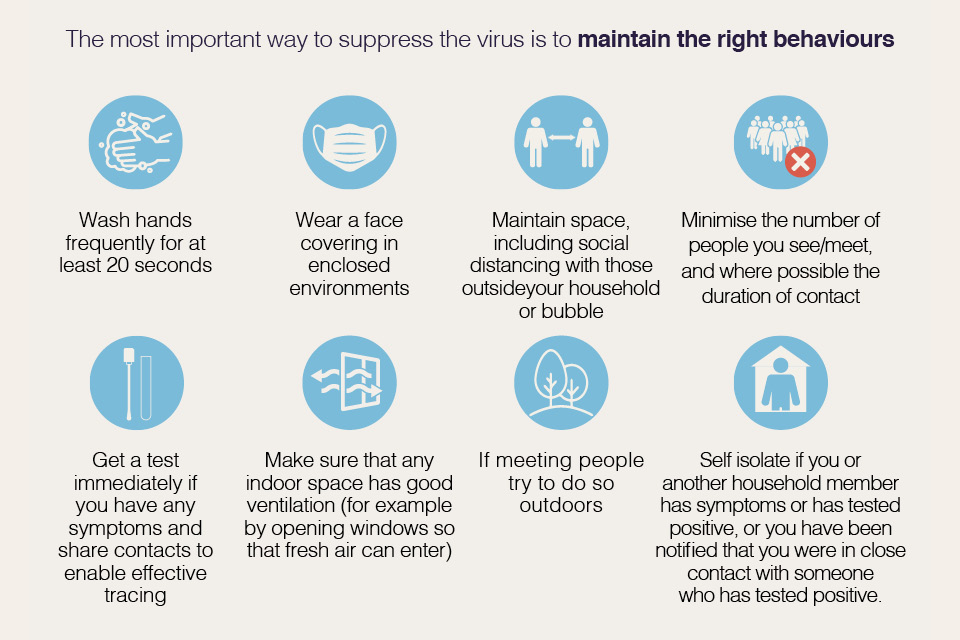
An infographic showing the most important behaviours to maintain in order to suppress the virus. Eight behaviours are shown: wash hands for 20 seconds, wear a face covering in enclosed environments, maintain social distancing, minimise the number of people you see and the duration of contact, get a test immediately if you have symptoms, make sure any indoor space is well ventilated, if meeting people, try to do so outdoors, self isolate if you or another household member has symptoms or has tested positive.
The most important way to suppress the virus is if we all continue to follow the right behaviours.
This includes washing hands frequently for at least 20 seconds, wearing face coverings and ensuring there is plenty of fresh air in enclosed environments, maintaining social distancing and self-isolating when infection is suspected or confirmed.
The UK public have undoubtedly helped to reduce the spread of the virus by adopting these behaviours even where they may have caused social and economic hardship.
These behaviours will remain just as critical through the winter and we must all continue to play our part.
